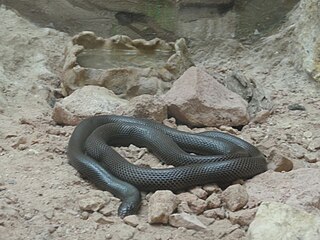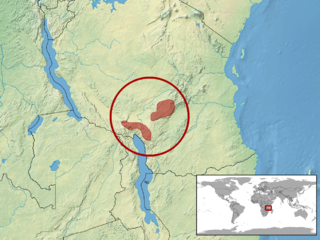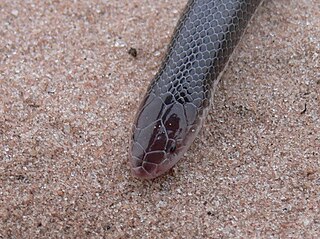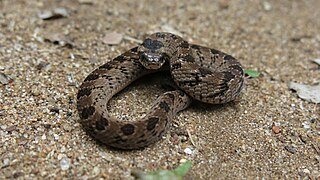
The Atractaspididae (atractaspidids) are a family of venomous snakes found in Africa and the Middle East, commonly called mole vipers, stiletto snakes, or burrowing asps. Currently, 12 genera are recognized.

Atractaspis is a genus of venomous snakes in the family Lamprophiidae. The genus is endemic to Africa and the Middle East. The genus contains 15 species that are recognized by ITIS. Others recognize as many as 21 species. 23 are listed here.

Atheris barbouri is a small and rare terrestrial species of viper endemic to the Uzungwe and Ukinga mountains of south-central Tanzania in Africa. No subspecies are recognized.

Atractaspis bibronii is a species of venomous snake in the family Atractaspididae. The species is endemic to Africa. There are no subspecies that are recognized as being valid.

Bitis worthingtoni, also known commonly as the Kenya horned viper and the Kenyan horned viper, is a species of venomous snake in the subfamily Viperinae of the family Viperidae. The species is endemic Kenya. There are no subspecies that are recognized as being valid.

Causus defilippii, commonly known as snouted night adder, is a species of snake in the family Viperidae. The species is endemic to East and Southern Africa. Although its venom is nonlethal to humans, it is still considered medically significant. There are no recognized subspecies.
Atractaspis battersbyi, also known commonly as Battersby's burrowing asp and Battersby's mole viper, is a species of venomous snake in the family Atractaspididae. The species is native to Central Africa.
Atractaspis boulengeri, also known commonly as Boulenger's mole viper, the Central African burrowing asp, and simply the mole viper, is a species of venomous snake in the subfamily Atractaspidinae of the family Lamprophiidae. The species is endemic to Africa. There are six recognized subspecies.

Atractaspis duerdeni, commonly known as the beaked burrowing asp, Duerden's burrowing asp, and Duerden's stiletto snake, is a species of venomous snake in the family Atractaspididae. The species is native to southern Africa.
Atractaspis scorteccii, commonly known as Scortecci's mole viper or the Somali burrowing asp, is a species of venomous snake in the family Atractaspididae.
Chilorhinophis butleri, also known commonly as Butler's black-and-yellow burrowing snake and Butler's two-headed snake, is a species of venomous snake in the family Atractaspididae. The species is endemic to East Africa.
Micrelaps vaillanti, also known commonly as the black-headed micrelaps or the Somali two-headed snake, is a species of venomous rear-fanged snake in the family Lamprophiidae. The species is endemic to Africa.
Drewes's worm snake is a species of snake in the family Leptotyphlopidae. The species is native to East Africa.
Scortecci's blind snake, also known commonly as Bracciani's worm snake, is a species of snake in the family Leptotyphlopidae. The species is endemic to the Horn of Africa.
Crotaphopeltis tornieri, also known commonly as Tornier's cat snake and Werner's cat snake, is a species of snake in the family Colubridae. The species is endemic to Africa.
Degen's water snake, also known commonly as Degen's herald snake and the yellow-flanked snake, is a species of snake in the family Colubridae. The species is native to Sub-Saharan Africa.
Crotaphopeltis braestrupi is a species of snake in the family Colubridae. The species is endemic to East Africa.
Hemidactylus bavazzanoi, also known commonly as Bavazzano's gecko, the Somali banded gecko, and the Somali leaf-toed gecko, is a species of lizard in the family Gekkonidae. The species is native to eastern Africa.
Mochlus tanae, also known commonly as Loveridge's writhing skink or the Tana River writhing skink, is a species of lizard in the family Scincidae. The species is native to East Africa.

Philothamnus battersbyi, also known commonly as Battersby's green snake, is a species of snake in the family Colubridae. The species is native to northeastern Africa.








